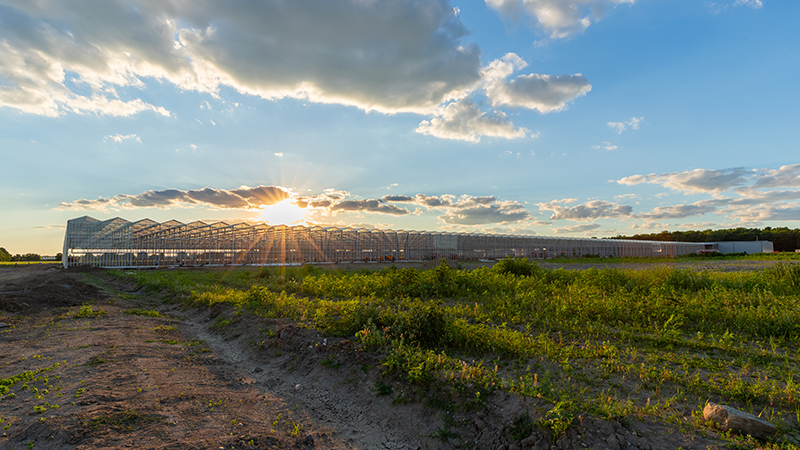Understanding Plant Nutrition: Environmentally Induced Plants

Most nutrients are actively taken up by the plant from the soil solution. With active uptake, the plant roots use energy to scavenge the root environment for soluble nutrients. For nutrients that are taken up actively (like nitrogen or phosphorus), their concentration in the root medium (as measured with soil tests) tends to correlate well to uptake by the plant.
The exceptions to this rule are calcium and boron. Calcium and boron are taken up passively by the plant. With passive uptake, nutrients only move into the plant along with the water used for transpiration. No transpiration, no uptake, regardless of the concentration of those nutrients in the soil solution.
The environment where the plants are being grown will directly affect transpiration rates, and calcium and boron uptake. The types of environments that suppress transpiration can include:
– Hot, humid conditions, especially when light levels have been reduced with excess shade.
– Cool, humid conditions, especially when no de-humidification is occurring.
– Greenhouses with little or no air movement, especially when conditions are humid.
Other management factors can also reduce transpiration rates and affect calcium and boron uptake. For example, a high salt level (high EC) in the root media will reduce transpiration by making it harder for the plant to take up water out of the soil solution. Constant overwatering or underwatering may also reduce transpiration rates.
What Else Affects Calcium & Boron Uptake?
Don’t forget to check roots. Calcium and boron are only taken up by the plant at the root tip. Root tip damage caused by salt burn, overwatering, fungus gnats or root pathogens such as Pythium can cause calcium or boron deficiency symptoms similar to those caused by environmental conditions. In that case, careful irrigation and a fungicide are required in order to grow a healthy root system and improve nutrient uptake.
Diagnosing Calcium & Boron Deficiency
Diagnosing environmentally induced calcium or boron deficiency in a crop can be difficult, especially if it has not been noticed before. Plants often do not show any discoloration at first. Environmentally induced problems will also seem to appear or disappear at random, or may appear on one crop, but not another.
Another difficulty is the common methods for diagnosing nutritional problems (soil tests or tissue tests) may be of little use. For example, it is common to see adequate concentrations of calcium or boron contained in the soil (based on a soil test), but because of environmental conditions, it is not getting into the plant.
Tissue testing may also show adequate concentrations of calcium or boron in the tissue. The problem is both calcium and boron will accumulate in the tissue as the leaf ages. So older leaves, like the newest fully expanded leaves that are recommended for tissue testing in larger plants, may have adequate levels of calcium or boron in the tissue, but the new growth is deficient. With plugs and liners, the entire plant is often tested. Again, the older leaves often have accumulated calcium or boron over time, and because their mass represents a much greater portion of the tissue than the new growth, it will cover up a deficiency at the growing tip.
Plant appearance often becomes the most effective tool for determining calcium and boron deficiency. With calcium, the early symptoms start on the new leaves as leaf distortion followed by chlorosis and necrosis of the leaf edge (Figure 1). If calcium deficiency progresses further, you might also see growing tip death, deformed flowers or short, thick roots.
With boron, the early symptoms also start on the new leaves as leaf distortion, but the tissue also gets thick and leathery, and the leaf petiole gets elongated. Often the growing tip dies, followed by the production of a large number of new growing tips, often called a “witch’s broom” (Figure 2). Sometimes, flower formation is also affected.
Corrections
Calcium: Additional sources of calcium that can be added to a nutritional program can include incorporating gypsum (CaSO4) into the media at 1 to 2 lbs/yd³ at mixing or adding calcium nitrate (Ca(NO3)2) to the fertilizer solution. Limestone is also a calcium source but is not a reliable source under all conditions.
Be careful when using additional calcium nitrate in the fertilizer because it can change the pH effect of the fertilizer. It is not recommended to use calcium nitrate as the only water-soluble fertilizer. Plants need all nutrients on a regular basis. Applying an unbalanced fertilizer like calcium nitrate for more than one or two irrigations can easily cause other deficiency problems.
When adequate calcium is being applied, but is not being taken up by the plant, then anything that increases transpiration, like lowering the humidity levels in greenhouse or increased air movement, will increase calcium uptake.
Foliar spraying calcium can also work to increase calcium nutrition, but should be thought of as a last resort and must be done proactively to be effective. The typical recommendation is to use a weekly spray of 400 ppm calcium (1 pound CaCl2 or 1.25 lbs Ca(NO3)2 per 100 gallons). As with all foliar sprays, adding a spreader to the spray solution will increase its effectiveness. Foliar sprays should be done early in the morning so they remain on the leaf surface as a liquid for the longest time possible.
Boron: Be extremely careful applying extra boron to a crop. The problem is that the difference between boron deficiency, adequate boron levels and boron toxicity is much smaller than any other nutrient. If the applied concentration is too high or the high concentrations are applied too frequently, then it is very easy to get boron toxicity (Figure 3).
Common boron rates in fertilizer solutions range from 0.1 to 0.4 ppm B. If these concentrations are inadequate, the first step is to try to increase transpiration rates. Supplemental boron drenches should only be used if it is not possible to increase transpiration rates. Supplemental drench rates of 1 to 2 ppm B applied one to two times during a crop have been shown to improve boron nutrition. Unfortunately, there is no good recommendation for foliar spraying boron at this time.
Be Proactive
Like most problems, prevention works best. Learn to recognize the type of environment that induces calcium and boron deficiency. If those conditions occur regularly, then it may be best to adjust your nutrition program accordingly. Remember, increasing the amount of calcium or boron applied to the crop may reduce the risk of environmentally induced deficiencies, but may not solve the problem under all conditions.










